A beam of white light falling on a glass prism gets split up into seven colours marked 1 to 7 as shown in the diagram.
A student makes the following statements about the spectrum observed on the screen.
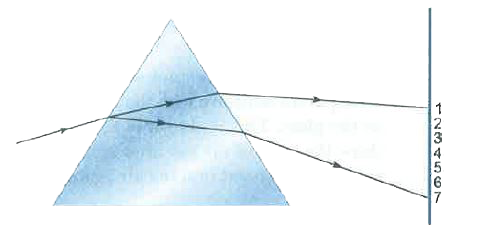
(a) The colours at positions marked 3 and 5 are similar to the colour of the sky and the sky and the colour of gold metal respectively. Is the above statement made by the student correct or incorrect? Justify.
(b) Which two positions correspond closely to the colour of
(i) brinjal, (ii) 'danger’ or stop signal lights?
(a) The statement made by the student is incorrect.
Positions marked 3 (yellow) and 5 (blue) are similar to the colour of gold metal and the colour of the sky respectively. The student is stating the nature of colours in reverse order.
(b) (i) The position marked 7 (violet) corresponds closely to the colour of a brinjal.
(ii) The position marked 1 (red) corresponds closely to the colous of .danger. or stop signal lights.
Topper's Solved these Questions
- BOOK - VK GLOBAL PUBLICATIONCHAPTER - PRACTICAL BASED QUESTIONSEXERCISE - Experiment 146videos
PRACTICAL BASED QUESTIONS
- BOOK - VK GLOBAL PUBLICATIONCHAPTER - PRACTICAL BASED QUESTIONSEXERCISE - Experiment 154videos
PRACTICAL BASED QUESTIONS
- BOOK - VK GLOBAL PUBLICATIONCHAPTER - PRACTICAL BASED QUESTIONSEXERCISE - Experiment 126videos
PRACTICAL BASED QUESTIONS
- BOOK - VK GLOBAL PUBLICATIONCHAPTER - PERIODIC CLASSIFICATION OF ELEMENTS EXERCISE - PROFICIENCY EXERCISE (LONG ANSWER QUESTIONS)3videos
PERIODIC CLASSIFICATION OF ELEMENTS
- BOOK - VK GLOBAL PUBLICATIONCHAPTER - VALUE-BASED QUESTIONSEXERCISE - EXERCISE (CHAPTER-16) MANAGEMENT OF NATURAL RESOURCES9videos
VALUE-BASED QUESTIONS
Similar Questions
A beam of white light falling on a glass prism gets split up into seven colours marked 1 to 7 as shown in the diagram.
A student makes the following statements about the spectrum observed on the screen.
(a) The colours at positions marked 3 and 5 are similar to the colour of the sky and the colour of gold metal respectively.
Is the above statement made by the student correct or incorrect? Justify.
(b) Which two positions correspond closely to the colour of
(i) brinjal, (ii) 'danger' or stop signal lights?
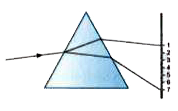 View Solution
View SolutionA beam of white light falling on a glass prism gets split into seven colours marked 1 to 7.

The colour at positions marked 1 and 3 are similar to the colour of 'turmeric and the colour of "Chilli powder, respectively. Is the above statement correct or incorrect?View Solution
Knowledge Check
- Question 1 - Select One
When a beam of white light passes through a glass prism, it splits up into seven colours. This phenomenon is due to
Arefraction of light.Bdispersion of lightCdiffraction of light.Dabsorption of light. - Question 2 - Select One
When light splits after passing through a glass prism into seven colours, the phenomenon is called
Areflection of lightBrefraction of lightCdispersion of lightDspectrum - Question 3 - Select One
A beam of white light falls on a glass prism. The colour of light which undergoes the least bending on passing through the glass prism is :
AvioletBredCgreenDblue
A beam of white light falling on a glass prism gets split into seven colours marked 1 to 7.
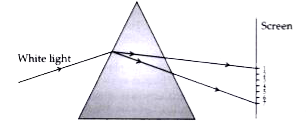
Which two positions correspond to the colour of solution of copper sulphate and signal used to move the vehicles?View SolutionA beam of white light falling on a glass prism gets split into seven colours marked 1 to 7.
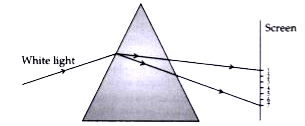
Light of colour of chilli powder bends the most while the light of colour of brinjal bends the least. Is the statement correct?View SolutionA beam of white light falling on a glass prism gets split into seven colours marked 1 to 7.
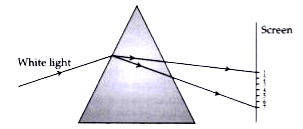
Which of the following statements is correct regarding the propagation of light of different colours of white light in air?
(i) Red light moves fastest
(ii) Blue light moves faster than green light
(iii) All the colours of the white light move with the same speed
(iv) Yellow light moves with the mean speed as that of the red and the violet light.View SolutionSplitting of white light into seven colours is called :
View SolutionThe phenomenon of splitting white light into seven colours is called
View Solution

